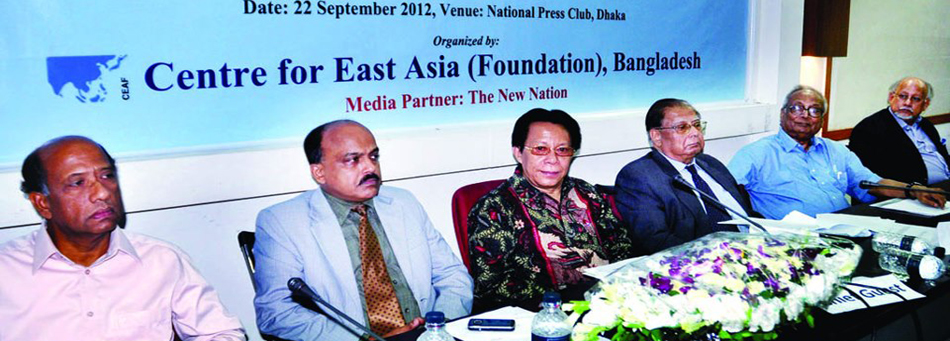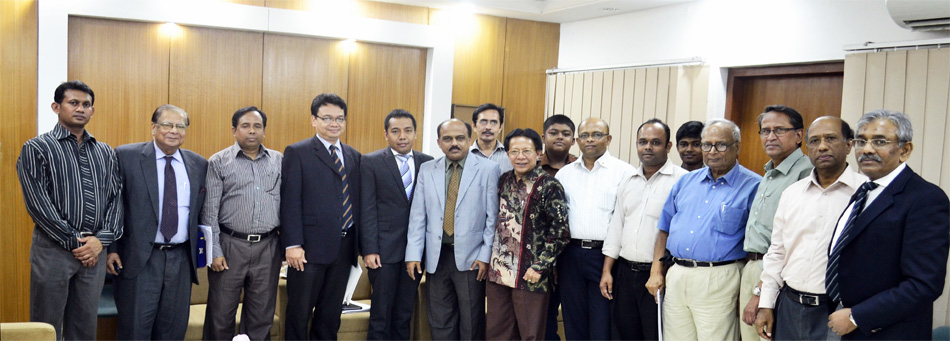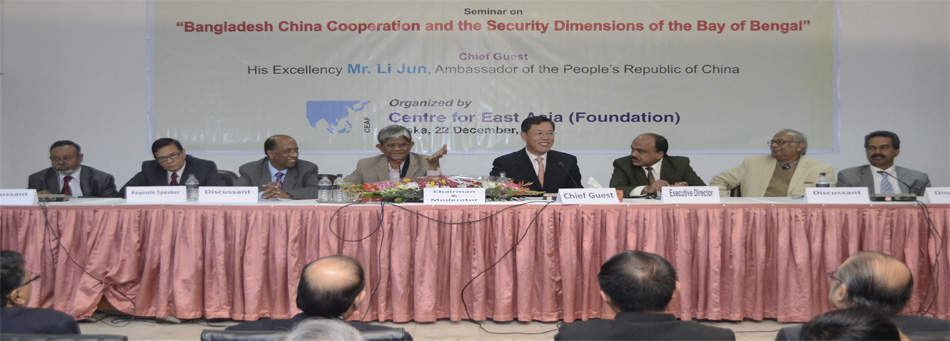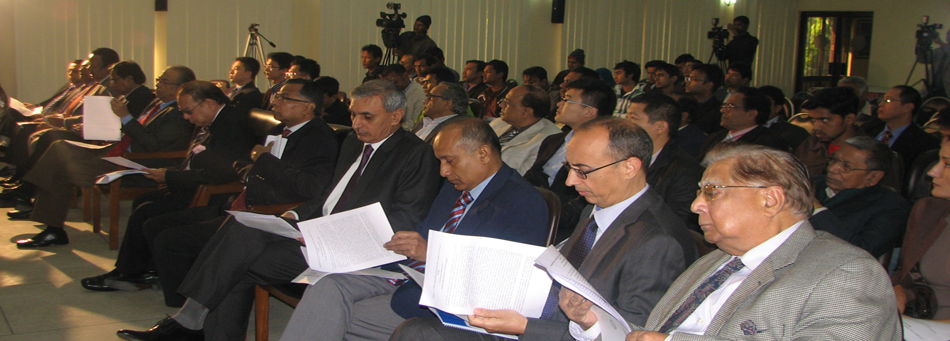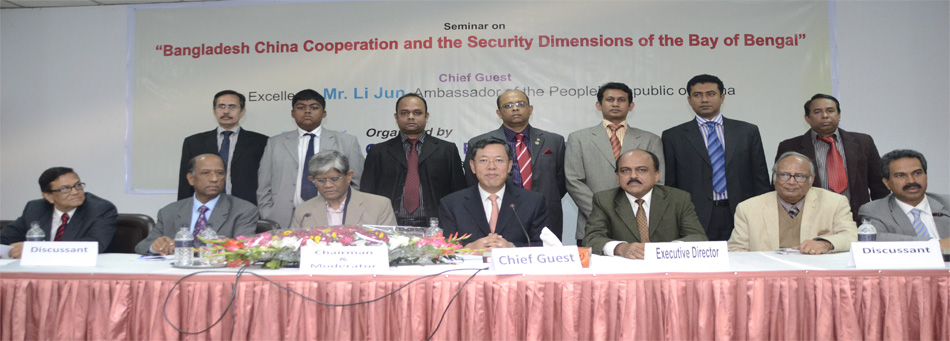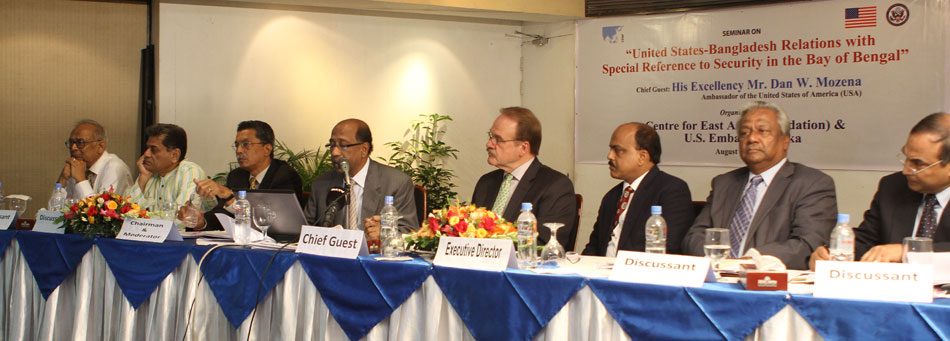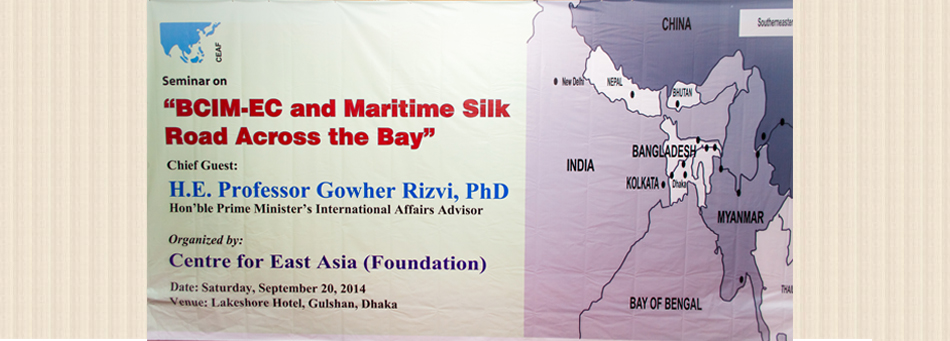Articles:
Brief prepared by CEAF research team for paper-writers of the seminar on BCIM-Economic Corridor and Maritime Silk Road across the Bay
1. The Maritime Silk Road, according to some analysts, is the Chinese answer to US ‘Pivot to Asia’. It is a strategy of soft power projection, as Chinese economy steadily grows to overtake the United States, vis-a-vis the military “rebalancing” strategy of the U.S.A. The naval power projection of US Asia Pacific Command is sought to be made irrelevant by a commonwealth of interests in safety and security of international trade along the Maritime Silk Road, China being in the driving seat of trade growth along that route (vide blue lines in Map 1, Italy to Japan.) Umbrella of US Naval power, however, has eager clients and partners in the Indian Ocean and Pacific Ocean span, such as the Gulf Cooperation Council led by Saudi Arabia, India, Singapore, Vietnam, the Philippines, South Korea and Japan. Indonesia and Bangladesh are also being paid increasing naval attention by US power. For the time being, Chinese dictum of “peaceful rise” and US avowal of “competition and cooperation” with China appears to offer the guarantee for peace and stability in the Asia-Pacific.
2. Revival of the ancient Great Silk Road remodeled “from China and Afghanistan to Palestine and Balkans” was also an American idea in the aftermath of its emergence as the sole superpower at the end of the Cold War. A US Silk Road strategy paper at the threshold of the current millennium read as follows: “After the collapse of the Soviet Union and the consequent emergence of the five independent Central Asian republics of Uzbekistan, Kyrgyzstan, Turkmenistan, Kazakhstan, and Tajikistan, major efforts have been undertaken to revive the Silk Road for cultural exchange, trade and tourism. The President of the Kyrgyz Republic, Askar Akaev, expressed the hope that it will be ‘possible to create conditions for the transformation of the entire region into an area of stability, security, friendship, co-operation and equitable partnership’.
“Apart from being a major trading route the Great Silk Road was of immeasurable significance in the establishment and maintenance of diplomatic relations. Today there is a revival of the Silk Road Diplomacy as technological advances in information communication systems and networks speed up the process of globalisation and increasing interdependence. The dynamic development of political, trade and economic relations needs strengthening if mutually advantageous partnerships are to develop between all States on the Silk Road.
“The modern day arms race, local conflicts, terrorism, narcotic criminal activity, natural disasters and urgent unmet social needs are major problems leading to increased awareness of the need to resolve chronic problems by peaceful negotiation. The advantages offered by regional integration and co-operation are clear and as information infrastructures enable the region to access the world-wide computer networks, the power of information technology can be harnessed in support of the drive for economic stability and the development of business and civil society. The United States is actively promoting Silk Road development in recognition of the strategic importance of the countries encompassed within the Silk Road and in 1999 the U.S. Senate adopted a Silk Road Strategy Act. U.S. Senator Sam Brownbeck who introduced the Bill to the Senate, saying: ‘The Silk Road countries of the South Caucasus and Central Asia are at an historic crossroad: they are independent, they are at the juncture of many of today's major world forces, they are rich in natural resources, and they are in the midst of nation building.’
“The countries of the Silk Road Strategy included Armenia, Azerbaijan, Bhutan, China, DPR Korea, Egypt, Georgia, Israel, Iran, Iraq, Japan, Jordan, Kazakhstan, Kyrgyzstan, Mongolia, Nepal, Pakistan, Republic of Korea, Russian Federation, Syrian Arab Republic, Tajikistan, Turkey, Turkmenistan, Uzbekistan as well as Afghanistan, northern India and the Balkans.”
3. But the US New Silk Road strategy has been largely frustrated by the indeterminate results of its Af-Pak policy at one end, and Russian confrontation against attempted US-NATO extension of influence in Caucasus and in Ukraine. The relevant independent Central Asian states have meanwhile been effectively incorporated into the Sanghai Cooperation Organisation, in which countries of observer status include Iran, Afghanistan, Pakistan, India and Mongolia. China undertook its own network of Silk Road revival and energy connectivity covering the entire Eurasian theatre. Gas and Oil pipeline network, projects and contracts of Russia and China with oil-rich Central Asian states, such as Gazprom controlled Central Asia – Center (CAC) 1, 2, 4 and 5 pipelines, and the Turkmenistan-China gas pipeline, virtually elbowed to sidelines the Western oil companies’ Caspian Pipeline Consortium, and other initiatives. Competition over control of major pipelines notwithstanding, much of the oil and gas flowing through them reach the global market and Western refineries, through Russia and also avoiding Russia through-Baku-Tbilisi-Ceyhan pipeline.
4. Like the oil and gas pipelines, the revived Silk Road network on land serves the causes of globalisation, although US Silk Road Strategy Act, 1999 has become inconsequential. The Maritime Silk Road is also the revival of ancient Han Dynasty sea-faring routes, which expanded and boomed as nomadic turmoil increasingly erupted in Central Asia in the eighth century, flourishing upto the end of the 14th century. Undermined by later Ming and Qing dynasties, the Silk Road on the Sea was finished off totally by the nineteenth century Opium Wars by waged British colonialists.
Chinese President Xi Jinping put forward the matter of reshaping that old oceanic connectivity into a 21st Century Maritime Silk Road during his South East Asian Tour in 2013. Interestingly, the 21st Century Maritime Silk Road initiative with implicit Chinese guarantee of its collective protection provides the lifeline of communication for a Regional Comprehensive Economic Partnership initiative by Japan, seeking to take India and Bangladesh on a Journey to Free Trade Areas of the Asia-Pacific. (vide Figures 1 and 2)
5. The Japanese drive behind the concept, according to a presentation by JETRO (Japan External Trade Organisation) of “RCEP”, Regional Comprehensive Economic Partnership had begun with sixteen nations in Asia consisting of 10 ASEAN members, Japan, South Korea, China, Australia, New Zealand and India. They are discussing economic integration under this MEGA economic treaty. RECP was announced on November 2012 by ASEAN, and the 16th countries had several meetings, aiming to conclude the negotiation by 2015. We try to make rules and regulations that is friendly to international supply chain by synchronizing procedures. RCEP nations consist of 30% of the world GDP, 50% of world population, who under the scheme would be able to do activities like import, export, move, invest and expand freely, for any business located in RCEP nations.
6. Bangladesh and Myanmar are being sought to be brought under the RCEP umbrella by the Japanese investment scheme in BIG-B, or Bay of Bengal Industrial Growth Belt. The BIG-B plan in respect of Bangladesh has been offered in a paper prepared by JICA (Japan International Cooperation Agency) as follows.
BIG-B has three main pillars. The first pillar is industry and trade. This pillar mainly consists of constructing a long-awaited deep sea port at the Matarbari Island. This will offer Bangladesh an important trade gateway to the rest of Asia and beyond.
The second pillar is energy. Matarbari Island can be developed into a massive supply base of primary energy (such as coal, LNG, and oil). The electricity produced from those sources can support a quantum leap in industry and trade, not only within the area covered by BIG-B but also all over Bangladesh. Recognizing the promise this holds, Power Division and the Bangladesh Power Development Board have already embarked on developing electricity infrastructure throughout the entire area to facilitate greater diversification of the country's energy mix.
Transportation is the third pillar of BIG-B. To enable greater industry, trade, and energy production, the Dhaka-Chittagong-Cox's Bazar transport artery needs to be strengthened and even extended to neighboring countries. More and better national highways and railways are an absolute must to accelerate the movement of goods and people that is essential for highly vibrant industrial agglomeration. The fact that the Roads Division of the Ministry of Communication and the Ministry of Railways have shown a strong commitment to address this urgent need.
BIG-B is also an appropriate strategy for Bangladesh in the sense that the country is now poised to capitalize on three promising economic opportunities. The first opportunity is the cost-competitiveness of Bangladeshi labor in the global marketplace, which is still strong. The second opportunity is the current trend of regional integration. The Regional Comprehensive Economic Partnership, which is currently being negotiated among ten ASEAN countries, Japan, China, South Korea, Australia, New Zealand and India, is one manifestation of this trend. Bangladesh could benefit more by joining in it.
The third opportunity is provided by the strategic location of Bangladesh, a country between the Indian Ocean and the Asian continent and a country between Southeast Asia and South Asia. Bangladesh can provide the gateway to the Bay of Bengal for the South Asian hinterlands comprising Bhutan, Nepal and India's seven North-Eastern states. These land-locked places are now considered to be a huge untapped market with more than 70 million people. This means that Bangladesh can be a "hub" of the Bengal regional economy.
7. The BCIM-EC concept is also a revival of a Southern trade and travel route of merchandise as well as men of learning, historically remembered more as a route of cultural transmission. Chinese merchants scaled through difficult mountain passes to open up the route for commerce with Juandu (India). Although it branched off to Vietnam in the East and in the West up to Middle East through Myanmar and India, the cultural proactive core part of the road, Southwest Silk Road from Chinese angle, traversed from Chengdu to Dali in China to reach Magadha (near Patna) in Bengal-Bihar belt of the Pala period going further to Lhasa in Tibet across the Himalayas to return to Chengdu. (vide mauve line enclosure in Map 1). At present, under Indian compulsions of security of the corridor for this revived Southwest Silk Road, taking into account separatist troubles in the Indian northeast, the BCIM-EC has been agreed on to be primarily a K to K (Kunming to Kolkata) connection, avoiding sensitive pockets of insurgent activity in Nagaland, Assam, Manipur and Tripura in the Indian territory (vide Figure 3).
8. Bangladeshi experts observe that strategic roads survive if trade and traffic favours such route-plans. 20th Century Stilwell Road built by British Army during World War 2 connecting Indian northeast through Myanmar to China has not survived. But the 16th century Grand Trunk Road built by Sher Shah connecting Kabul to Sonargaon of the-then Bengal Sultanate (extended to Kolkata by the British) has stood the test of time. Bangladesh expects trade and traffic to grow along a direct route from Chittagong through Myanmar (right now somewhat disaffected by ethnic discord between Rohingyas and Rakhaines, but certainly less complicated than those in Indian northeast) to Kunming and other parts of Western China. A dept-sea port off Chittagong could provide a vital link to the 21st Century Maritime Silk Road to this land route of BCIM-EC, in turn branching off to Tripura, Assam and Manipur in Indian northeast, to Nepal and Bhutan, and to Shiliguri, Patna (Magadha) and Kolkata in the Indian mainland.
9. The people of Myanmar, which obtained the Chair of the ASEAN community in 2014 and forms the westernmost flank of that community had been rendered temperamentally recluse through the 20th century by colonial domination followed by long civil wars in post World War postcolonial trauma. It has emerged in the 21st century as a very important link by land and sea within the Regional Comprehensive Economic Partnership as conceived by Japan and also within the Silk Road Economic Belt and its nautical complement Marine Silk Road as conceived by China. It has nine sea-ports along the Bay already operational and equal to the number of Indian seaports along the Bay excepting India’s naval base in the Andamans. Thailand has four sea-ports operational along the Bay of Bengal, and Bangladesh has two. (vide Figures 4, 5, 6 and 7). Myanmar is thus undoubtedly the most ready candidate to link up BCIM-EC with Marine Silk Road across the Bay. Bangladesh has to do more and decide quickly on deep-sea ports to catch up with Myanmar in the service of the BCIM-EC community and neighbourly eastern sub-Himalayan states of Nepal and Bhutan.








Bangladesh must not forget to look East
Bangladesh-Myanmar 40 years of Diplomatic Relations.
Bangladesh and Myanmar, two neighboring Least Developed Countries of Asia. On 13 January, 1972, Myanmar was the sixth state to accord recognition to new born Bangladesh that emerged as a sovereign independent state. Geography apart, Bangladesh has historic ties with Myanmar including a common colonial legacy. Geographically present Myanmar, is the only direct neighbor that we have across our land borders other than India. Geo-strategically, Myanmar provides for Bangladesh a possible gateway
to China as well as to South-East Asia. This year the two neighbor celebrate 40 years of their diplomatic relations. And although during these years some tensions developed sporadically between the two neighbors in particular about land border traffic and trade management, refugees and maritime boundary demarcation, relationship between the two countries remained on sound footing and differences addressed by sustained and peaceful negotiations.
As early as in May 1972, the-then Bangladesh Foreign Minister visited Myanmar. That was the first official visit by the Foreign Minister of Bangladesh to any country after India. Following the visit, a joint communiqué was issued simultaneously from Bangladesh and Myanmar. The communiqué declared intent to maintain close ties and develop bilateral relations on the basis of peaceful co-existence, non-alignment and mutual respect for sovereignty, territorian integrity and national dignity. These still remain the basis of Bangladesh-Myanmar ties. Between 1972 and 1985, the two countries signed three important agreements. These were : (i) General Trade Agreement (3 August, 1973), (ii) Repatriation of Refugee Agreement (1978) and (iii) Land Boundary Agreement (1979). These agreements were milestones for the relations between the two countries. Since then many top level visits took place from both sides to boost up Bangladesh-Myanmar ties. The visit to the-then Prime Minister General Than Shaw to Bangladesh in December 2002 and subsequent visit of Bangladesh Prime Minister Begum Khaleda Zia to Myanmar in March 2003, were important developments in Bangladesh-Myanmar relations. The summit between the two leaders produced a number of good decisions. In March 2003, three agreements, namely Coastal Shipping, Trade Account, and Joint Business Council agreements, were concluded. In all, there were 10 agreements between the two countries, but many of them had remained only as paper exercise. The broder agreement is an exception. In the same year, the second Bangladesh trade fair took place in Myanmar. A cultural troupe from Bangladesh consisting of 116 members performed their cultural show for four days. Five years later Myanmar Vice Senior General Maung Aye visited Bangladesh in October 2008 and Bangladesh Foreign Minister Dipu Moni visited Myanmar in May 2009. They held discussions on the core issues of bilateral relations.
The amount of bilateral trade is small. Myanmar exports to Bangladesh such items as marine products, beans and pulses, and kitchen crops, while it imports from Bangladesh pharmaceuticals, ceramic, cotton fabric, raw jute, kitchenware and cosmetics. It is reported that in 2010-11 Bangladesh’s export stood at $ 9.65 million and imports from Myanmar at $ 175.7 million. To increase trade, the joint trade commission (JTC) of Bangladesh and Myanmar held its 5th meeting in July 2011. It was agreed that the two countries would raise bilateral trade to $550 million from $185.3 million now. They also discussed how to complete border transactions through the Asian Clearing Union (ACU) payment system. Bangladeshi importers now settle their payments for bulk shipments through third counrty bank drafts issued by foreign banks.
Myanmar is close door neighbor to Bangladesh but it is too distant to travel by air because one has to fly first to third country and then to Myanmar from Bangladesh and vice versa. There are no air links, no road links and no coastal shipping connections between the two neighbors. This is unexpectable is the age of globalization where countries across the world have been efficiently interconnected.
Bangladesh Prime Minister visited Myanmar on December 2011 for strengthened the bilateral relations and mutual trade between the two countries. After the official bilateral meeting between Sheikh Hasina and Myanmar president U Thein Sein in Myanmarese new capital Nay Pyi Taw they stated the 15 point joint statement. The Bangladesh Prime Minister expressed Bangladesh’s willingness to import energy from Myanmar and requested the President to import Readymade Garments (RMG), Pharmaceutical products, Knitwear, Jute goods, Ceramic etc from Bangladesh at competitive price. Both the heads of state stressed upon the establishment of direct Banking arrangement Under Assian Clearing Union (ACU) and wished to launch direct air flight between Dhaka/Chittagong and Yangon. Prime Minister Sheikh Hasina also laid the foundation of Bangladesh chancery in the Diplomatic Zone of Nay Pyi Daw, new capital city of Myanmar. Bangladesh is the first country to lay the foundation of its chancery building in the diplomatic zone on about 7 acres of land.
It is desirable for Bangladesh to discard old mindsets and establish long term strategic relationships with the newer global power centers that are emerging in other parts of the world. Therefore, taking into account the changed strategic environment in the region, an overhaul of Bangladesh’s ‘Look East’ Policy is urgently needed. The ‘Look East’ policy of Bangladesh promises to bring not only commercial benefits to the country but can also improve its political and defense standing among the nations.
India, the close neighbor of Bangladesh by this time made significant advancement in achieving excellent relations with East Asian Countries in various sectors with a geometric progression. After liberalization of Indian economy from 1992 onwards, India started looking at the lucrative markets of ASEAN region as part of the ‘Look East Policy’. India has embarked on a policy of building closer relations with Myanmar to counter Chinese influence and facilitate the growth of trade and commerce with ASEAN. Following the admission of Myanmar as a member of the ASEAN in 1996 its importance in furthering India’s trade with ASEAN increased. Indian External Affairs Minister S.M. Krishna visited Myanmar last year. Krishna’s agenda were security, connectivity and investment. It was the first high level contact between the two countries since a new government took charge last year in Nay Pyi Daw, Myanmar’s Capital. India pledged $10 million towards capacity building on the agricultural sector in Myanmar. This sector is the back bone of Myanmar’s economy. Providing employment of 2/3rd of Myanmar’s people and contributing to 58% of its GDP and 48% of export earnings. India also setting up an agricultural research center at Yezin. In the health sector, India has agreed to provide sophisticated medical equipment to a children’s hospital in Yangon. The two state also concentrate on counter insurgency co-operation. India’s current Myanmar policy appears to be largely copying the methods adopted by the Chinese.
To improve connectivity with Myanmar, India has taken up a number of road and port construction projects. India has constructed the 160-km Tamu-Kalewa-Kalemyo road in Myanmar from Manipur border. It is also assisting in the proposed trilateral highway project to connect Moreh in Maniput to Mae Sot in Thailand via Bagan in Myanmar. India’s Kaladan multi-model transit transport facility is aimed at improving linkage between Indian ports on the eastern sea board and Sittwe port in Myanmar. This would enable transportation by river transport and road to Mizoram providing an alternative route for transport of goods to North-East India. A proposal to build a rail link from Jiribaum in Assam to Hanoi in Viet Nam through Myanmar is also on the cards.
On the other hand, China-Myanmar relations have a long history. As Myanmar’s biggest foreign investor, China has benefited from the isolation of its resource rich neighbor, buying up vast amounts of oil, gas and timber as it offered unwavering diplomatic support. China has stepped its influence through economic, military and development assistance. Once seen a Pariah state, Myanmar now appears to be trying to limit its dependence on Beijing by reaching out to The United States – as evidenced by us Secretary of State Hillary Clinton’s trip there last month. Trade between the two countries hit $4.4 billion in 2010, up by 53% from the previous year. China has signed a 30 year deal with Myanmar for the right to buy natural gas from its Shwe fields.
Nevertheless, China’s economic, political and military involvement in Myanmar is all-encompassing. China’s biggest interest by far are in oil, natural gas and hydroelectricity, as it seeks to fuel its breakneck economic expansion. China has begun construction on twin oil and natural gas pipelines going from the Myanmar port of Kyankpyu on the Bay of Bengal to Kunming, Capital of South-West China’s border province of Yunnan. Around 80% of China’s oil imports from the Middle East and Africa are currently transported through the Strait of Malacca, which Beijing fears could be choked off in the future due to geopolitical disputes. Due to this China’s strategic objective appears to be to gain direct access to Bay of Bengal and Andaman Sea through Myanmar bypassing the narrow Strait of Malacca.
Myanmar has a great deal of strategic significance for both India and China, whereas for Bangladesh it has a strategic twinning prospect for mutual security and economic cooperation. Indeed, Bangladesh’s foreign policy objectives should place a higher priority on maintaining friendly ties with East Asian Countries. Since both economic and military balance of power is shifting from Atlantic to Asia Pacific. Bangladesh’s interest to maintain pro-active relations with Myanmar is highly necessary for the reasons of national security and strategic advantages such as an alternative land route opening to China and South-East Asia. So, the tri-nation direct road linkstretching Bangladesh, Myanmar and China is another area where cooperation can greatly benefit the whole region. The extension of highway from Cox’s Bazer to Bawlibazer up to Kunming of China via Myanmar would contribute significantly. Furthermore, Bangladesh can take diplomatic initiative for the implementation of the proposed Trans-Asian Railway (TAR), a project of UNESCAP. Once materialized, it will link Bangladesh, among others, with six East Asian Countries such as Myanmar, Thailand, Loas, Combodia, Malaysia and Singapore as well as European Countries through Turkey. Consequently Bangladesh-Myanmar economic and commercial ties will greatly expand through this increased connectivity.
The balance of power among civilizations is shifting. The west is declining in relative influence. Asian civilizations are expanding their economic, political and military strength. Over the past six months, one of the world’s most striking and surprising political transformation has been underway in the South-East Asian nation of Myanmar. In the changing global and regional politics US Secretary of State Hillary Clinton visited to Myanmar last month marks a watershed in Myanmar-US relations. The changes in Myanmar have provided an opening to better relations with the United States of America at a time when the Obama administration is courting South-East Asian nations as China asserts its influence in the region. Since inauguration in March 2011, President Thein Sein has worked with the country’s newly established parliament to pass a draft of new laws. Labor Unions have been legalized, reform banking system, the internet has been mostly freed, the easing of restrictions on buying cars, human rights commission established. Moreover, Aung Suu Kyi freed from house arrest and her National League for Democracy (NLD) rejoins political process. She is now planning to take part in by elections expected this year. The government has also freed a member of political prisoners. The most amazing news for Myanmar is they granted ASEAN chair in 2014. Now, it is depicted that, Myanmar is the fertile land of investment and cooperation. Why not Bangladesh take such advantages from her next door neighbor?
To qualify as a significant regional player in the Bay of Bengal, Bangladesh should avail of the following strategic opportunities:-
| (a) |
To earn the confidence and trust of the Myanmarese government that Bangladesh is sincere about establishing bilateral relationship. |
| (b) |
To maintain favourable balance of power situation with Myanmar. |
| (c) |
To form strategic partnership with Myanmar and to consider it an indispensable part of Bangladesh’s ‘Look East’ policy. |
| (d) |
To resolve any disputes through dialogue and to avoid the possibility of military confrontations. |
| (e) |
To increase defense cooperation between the two state in the field of training, joint military exercise and exchange of sensitive security information. |
| (f) |
To launch an intense diplomatic effort, both bilateral and multilateral involving China. |
| (g) |
Myanmar is rich in natural resources but industrially still under developed. Bangladesh should encourage both by governmental aid and private investment in the following fields:
i) Agro-tech and forestry industries, ii) Small scale industries, iii) IT education and infra-structure, iv) Human Resource Development, v) Hotel industry and tourism, vi) Establishment of training institute specially launch a substantial English language teaching initiative in Myanmar supported by Dhaka University or any reputed Private University from Bangladesh. vii) To developed and modernized the banking facilities in Myanmar, viii) To supply skilled manpower in the field of Education, road, air, shipping, farming, marine fishing, ceramic, tourism, gas and hydropower sector. |
All unresolved issues between Bangladesh and Myanmar are in a process of resolution either bilaterally or under UN arbitration. Bangladesh and Myanmar could continue to improve their ties and they have many complementarities, potentialities, opportunities and areas of co-operation to improve their relations which will give them greater connectivity both at sub-regional and regional levels. On certain strategic issues, both countries have been trying to improve bilateral ties through regional and sub-regional forums such as the Bay of Bengal Initiative for Multi-Sectoral Technical and Economic Co-operation (BIMSTEC), The ARF, The Bangladesh-China-India-Myanmar Forum (BCIM) Strategically, Bangladesh can improve its balance of power situation with regional heavy weights by establishing relationships based on mutual interdependence and benefits and therefore attain more flexibility in devising policies that will protect her own national interests and will affect the future strategic direction of South and South-East Asia.
Myanmar and Bangladesh jointly are the bridge between ASEAN and SAARC. Bangladesh must take full advantage of the geo-strategic location of both countries for reasons of economic development & international relations.
The importance of geography in shaping foreign policy has long been recognized. Napoleon is supposed to have said, “Foreign policy of country is determined by its geography”. This is not just a hyperbole. There is no question that geographical factors have had a decisive effect upon civilizations and upon national & international development.
Nasim Mahmmud
Executive Director


“China’s PLA Long March to the 21st Century”
China’s remarkable economic & political growth over the past two decades has enabled it to achieve social progress and growing global influences not only for Northeast Asia but the World at large. The International Community Welcomes the rise of a stable and prosperous China. The latest defense white paper of China warns that the Asia Pacific region has become an increasingly significant stage for world economic development and strategic interaction between major powers. The paper warns that China still faces multiple and complicated security threats and challenges.
On the first of August People’s Liberation Army (PLA) of China Celebrates its 86th founding anniversary. The PLA initially established on 1st August, 1927 through Nanchang uprising of the communist against the Nationalist. It started as Red Army, took different names at different times and situation namely New Forth route Army, Eighth Route Army and finally all transformed to People’s Liberation Army (PLA), is now the unified military organization of all land, sea, strategic missile and air forces of the People’s Republic of China. The total strength of the PLA has been described in detail for the first time in a white paper published by the State Council Information Office of the Chinese Government. China now has about 850000 army servicemen in 18 combined operational divisions (brigades). Currently the PLA Navy has a total strengths of 235,000 officers and crew and commands 3 fleets the Beihai, the Donghai and the Nanhai fleet, The PLA Air force now has about 398000 officers and crew and an air commend in each of the seven military area commands of Shenyang, Beijing, Lanzhou, Jinan, Nanjing, Guangzhou and Chengdu. The PLA Second Artilery Force is a Core Force for China’s strategic deterrence. It mainly composed of nuclear and Conventional Missile forces and operational support units. The PLA is introducing sea skimming missiles, quicker submarines, and asymmetric capabilities in cyber space and other space (anti-satellite missiles), all designated to keep US carrier battle groups away from littoral areas around China in times of crisis.
The PLA is still the largest army in the world, with an active force of 2.3m. But China’s real military strength increasingly lies elsewhere. The Pentagon’s planners think China is intent on acquiring what is called in the Jargon A2/AD or “anti-access/area denial” capabilities. The idea is to use pinpoint ground attack and anti-ship missiles, a growing fleet of modern submarines and cyber and anti-satellite weapons to destroy and disable another nation’s military assets from afar. On June 30, 2011, The General Staff Headquarters of the PLA established an Information Technology Department by regrouping its communication department. Then IT department is directly subordinate to the General Staff Headquarters and will be in charge of the management, supervision and integration of the information systems and resources within the PLA. The PLA is intimately involved in Chinese space efforts. Its space program is civilian in nature. Unlike the Kennedy Space Center in Florida or the Johnson Space Center in Houston, China’s Space facilities are all manned and operated by elements of the PLA.
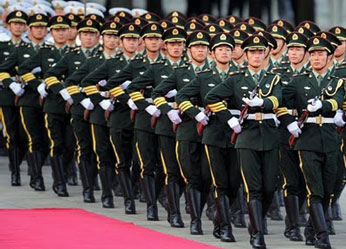
China’s latest defense white paper also spelled out the duty of the PLA to protect the country’s overseas interests, as security issues involving marine energy and resources, strategic sea lines of communication. First. the PLA should protect Chinese people overseas. It should participate in international peacekeeping operations to provide a safe environment for overseas Chinese Workers. Second. the PLA should protect national & personal wealth overseas. So for, China’s total investment abroad has reached US$50 billion & by 2020 the figure will surpass US$ 1 trillion. Third. the PLA should ensure the security of marine energy and resources. Fourth. the PLA should ensure the security of strategic sea lines of communication. More than 90% of China’s exported Cargos are freighted by sea. The PLA has gradually improved the quality of its educational system and thereby the basic educational level of its officers, though many significant problems remain. These changes in structures, teaching styles and contents, and goals have very significant implications for the combat potential of the PLA in the 21st Century.
After becoming simultaneously General Secretary of Communist Party of China (CPC) and Chairman of the Central Military Commission (CMC) at the 18th Chinese Communist Party Congress last November, Xi Jinping Consolidate his power base in the PLA. Xi has urged PLA forces to “get ready to fight & to Win Wars”. He has also pledged to continue boosting the PLA budget in double digits- and in particular, raising salaries and welfare of military personnel. China plans to raise its defense budget by 10.7% to 720.2 billion Yuan ($114.30 billion) in 2013. This year’s increase to the military budget is similar to the 11.20% increase in 2012. This year’s PLA budget increase has important implications for China’s military development, for its place in East Asia & the World, and for its neighbors and the United States. The Key dynamics are important, but should not be confused or conflated. Mr. Han Xudong, a professor at the University of National Defense Under the PLA said, China is planning to improve the transparency of its army and will hold 40 exercises with the military and paramilitary in 2013. According to the new regulation, the army should give priority to high tech Weapons, training & information technology, and tighten control over receptions, celebrations and overseas trips.
The PLA has increased its participation in a broadening array of multilateral security arrangements in recent years. One of the most high-profile aspects of this trend is the dramatic expansion in Chinese peace keeping developments (of Civilian police, military observers, engineering battalions and medical units) to UN operations. China was the fourteenth largest contributor to UN peace keeping operations, providing more troops, police and observers to UN operations than three other permanent members of the UN Security Council – Russia, The United Kingdom and the USA, China’s Overall effort, especially since the late 1990s, to become more responsive to international expectations while making positive and tangible contributions to global peace & security. China’s stepped up peace keeping activity parallels the PLA’s growing interest to expand its non-combat missions or “military operations other than war” (MOOTW) – disaster response, humanitarian relief and counter piracy- both in china and abroad, and put into action calls by former Chinese president Hu Jintao for the PLA perform “new historic missions” in the 21st Century. According to the recently released Chinese defense White Paper, more than 22000 peace keepers have been deployed to 23 UN operations. These contributions, including repeated development of engineering battalions and police Units, provide useful and practical experiences for Chinese security forces and help improve their responsiveness, riot control capabilities, coordination of military emergency command systems and ability to conduct MOOTW at home, a concept much touted in China’s recently release defense white paper. These benefits will be reinforced if, as expected, Chinese forces increasingly take on more dangerous and possibly combat missions as part of their expanded peace keeping activities.
The courage and solidarity of Chinese troops on UN peace keeping mission around the world has been praised by the UN Secretary General Ban Ki-Moon when he visited Beijing recently. He said, “China is a rising country in terms of political profile and economic development that also requires corresponding responsibility for world peace and development, Ban also said, “I have seen the bravery of Chinese blue helmets in helping struggling communities around the world.” For the International Community, China’s expansive engagement in peace keeping provides an important and widening window of opportunity to engage with China more closely on global security issues, help enlarge China’s Commitment to regional stability and contribute to more effective international peace keeping operations.
Through policy and practice, China has demonstrated to the outside World that it will bring about peace and stability to the nation, the region, and the world. Amid all the concerns, suspicions and apprehension, it appears that China aims to take bigger steps towards a more open and transparent PLA in the 21st Century.
Nasim Mahmmud
Executive Director
Centre for East Asia (Foundation)
E-mail: info@ceafasia.org




General Vo Nguyen Giap
- a Volcano Under Snow
General Vo Nguyen Giap, The icon of Vietnamese fighting spirit against odds, was the brilliant and ruthless commander who led the outgunned Vietnamese to victory first over the French and then the Americans. A national hero, Giap enjoyed a legacy second only to that of his mentor, founding president and independence leader Ho Chi Minh.
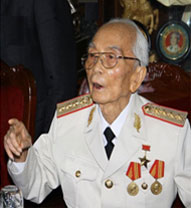
Born in the village of An Xa on August 25, 1911, Vo Nguyen Giap was the son of Vo Quang Nghiem. His father was a local scholar, as well as a farmer; Giap earned degrees in political economy and law from the University of Hanoi. He taught history and worked as a journalist until he was arrested in 1930, for supporting student’s strikes. Released 13 months later, he joined the communist party & began protesting against French rule of Indochina. He wrote poetry, and his French was impeccable. The French, though, were very much awared the fire of hatred that burned beneath, cool composure of Giap, who did not forget the memory of the deaths of his father and his first wife, after brutal torture, in French prisons.
They called him “a volcano under snow”. In 1939, Giap married fellow socialist Nguyen Thi Quang Thai. Their marriage was brief as he was forced to flee to China. In China, Giap joined up with Ho Chi Minh, the founder of the Vietnam Independence League. Between 1944 and 1945, Giap returned to Vietnam to organize guerrilla activity against the Japanese. At that time, he made an improbable soldier. He had no training and was not considered likely become a military commander. All the while, Giap was a dedicated reader of military history and philosophy. He revered Sun Tzu. He also made a particular study of Nepolean’s generalship, and greatly admired T.E. Lawrence’s “The Seven Pillars of Wisdom”, learning from it practical examples of how to apply minimum military force to maximum effect. Giap was made responsible for establishing an intelligence network and organizing political bases in the far north of the country. To begin propaganda work among the population, a news sheet called Viet Nam Doc Lap was produced. He was proud, hot tempered, blustered into a number of unnecessary pitched battles but won his two wars.
Giap is best remembered for leading Vietnamese forces to victory over the French at Dien Bien Phu in 1954. The unlikely victory-still studied at military schools – led to Vietnam’s independence and hastened the collapse of colonialism across Indochina and beyond. Giap then defeated the US based South Vietnam government in April 1975, reuniting a country that had been split into communist and noncommunist states. Against US forces with sophisticated weapons and B-52 bombers, Giap’s guerrillas prevailed again. But more than 1 million of his troops died in what is known in Vietnam as the “American War”. Historian Stanley Karnow, who quoted Giap as saying, “we were not strong enough to drive out a half-million American troops, but that was not our aim. Our intention was to break the will of the American government to continue the War.” On April 30, 1975 communist forces marched through Saigon with tanks, bulldozing the gates of what was then known as Independence palace. That victory came at a price for all sides: the deaths of many as 3 million communists and civilians, an estimated 25,000 South Vietnamese troops and 58000 Americans. On 28 August 1945, Giap had led his men into Hanoi, and on 2 September Ho Chi Minh declared the independence of the Democratic Republic of Vietnam. Throughout most of the war, Giap served as defense minister, armed forces commander and a senior member of Vietnam’s ruling communist party. After Ho Chi Minh’s death in 1969, the glory for victory in 1975 went largely to General Van Tien Dung, Chief of the General Staff by the upcoming generation. Despite his diminishing influence with the government, the thin, white-haired man became even more beloved in Vietnam as he continued to speak out. Giap celebrated his 100th birthday in 2011. He was the author of several military texts including people’s Army, people’s War and Big Victory, Great Task. His text books on guerrilla warfare inspired revolutionaries and insurgents the world over. In 2004 prior to the battle’s 50th anniversary Giap told foreign journalists, “We are very proud that Vietnam was the first colony that could stand up and gain independence on its own”.
On October 4, 2013, a government official announced that Giap had died at Central Military Hospital in Hanoi, where he had been under old age care since 2009. He was 102. He was buried his home town in Quang Binn province in Central Vietnam. Communist Party Leader Nguyen Phu Trong said, “Giap is the general of the people and his name will be forever engraved in the history of the nation”. Leaders of the UN and its committees and agencies, ambassadors and diplomats in the UN subsequently expressed their deep condolences over the death of the legendary General. Thousands of people paid their respects to general Giap in Hanoi and at military centers across the Vietnam. Dao Huy Hoang a 21 year old Hanoi student said, “I never heard guns or bombs but I know our history. After uncle Ho & general Giap, it would be hard to find anyone like them, who dedicated their lives to the country without thinking of their personal interest.” Late in life, Giap encouraged warmer relations between Vietnam and the US, who reestablished ties in 1995 and have become close development partners. Vietnam has also recently looked forward to the cooperation of US military to balance China’s growing power in South China Sea. Where over lapping shelf regions and islands are in long standing disputes involving several nations. Giap said, “We can put the past behind. But we cannot completely forget it”.
Nasim Mahmmud
Executive Director
Centre for East Asia (Foundation)
E-mail: info@ceafasia.org

